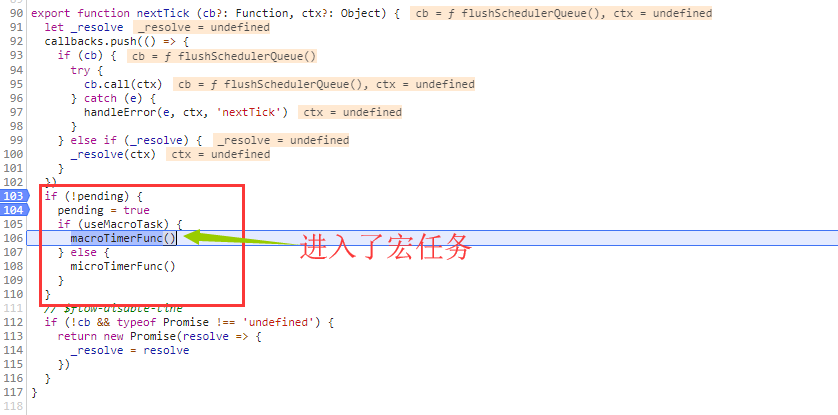$nexttick
刀刀
8/8/2025
0 字
0 分钟
- 来源:远方os;视频地址:前往学习
执行原理
在 Vue 更新 DOM 时是异步执行的。只要侦听到数据变化,Vue 将开启一个任务队列,并缓冲在同一时间循环中发生的所有数据变更。如果同一个 watcher 被多次触发,只会被推入到队列中一次。(这种在缓冲时去除重复数据对于避免不必要的计算和 DOM 操作是非常重要的)
然后,在下一个的事件循环 tick 中,Vue 刷新队列并执行任务队列 (已去重的) 工作。
方法 $nextTick 内部采用了一种异步队列技术,它采用了宏任务和微任务的处理机制来保证在 DOM 更新之后执行回调函数。这个方法的执行时间依赖于浏览器的刷新机制,也就是说,它的执行是在下一个浏览器刷新周期之前,而不是立刻执行。
宏任务还是微任务
首先查看一下核心代码—— nextTick 函数:
export function nextTick(cb?: Function, ctx?: Object) {
let _resolve;
callbacks.push(() => {
if (cb) {
try {
cb.call(ctx);
} catch (e) {
handleError(e, ctx, "nextTick");
}
} else if (_resolve) {
_resolve(ctx);
}
});
if (!pending) {
pending = true;
if (useMacroTask) {
macroTimerFunc();
} else {
microTimerFunc();
}
}
// $flow-disable-line
if (!cb && typeof Promise !== "undefined") {
return new Promise((resolve) => {
_resolve = resolve;
});
}
}更核心的代码:
if (!pending) {
pending = true;
if (useMacroTask) {
macroTimerFunc();
} else {
microTimerFunc();
}
}即:nextTick 既可以是宏任务,又可以是微任务!
接着看微任务的定义:
// Determine microtask defer implementation.
/* istanbul ignore next, $flow-disable-line */
if (typeof Promise !== "undefined" && isNative(Promise)) {
const p = Promise.resolve();
microTimerFunc = () => {
p.then(flushCallbacks);
// in problematic UIWebViews, Promise.then doesn't completely break, but
// it can get stuck in a weird state where callbacks are pushed into the
// microtask queue but the queue isn't being flushed, until the browser
// needs to do some other work, e.g. handle a timer. Therefore we can
// "force" the microtask queue to be flushed by adding an empty timer.
if (isIOS) setTimeout(noop);
};
} else {
// fallback to macro
microTimerFunc = macroTimerFunc;
}即:Vue 环境支持 Promis 的话,使用 Promis。否则 microTimerFunc 被定义为宏任务 macroTimerFunc。
接着看 macroTimerFunc 的定义:
// Determine (macro) task defer implementation.
// Technically setImmediate should be the ideal choice, but it's only available
// in IE. The only polyfill that consistently queues the callback after all DOM
// events triggered in the same loop is by using MessageChannel.
/* istanbul ignore if */
if (typeof setImmediate !== "undefined" && isNative(setImmediate)) {
macroTimerFunc = () => {
setImmediate(flushCallbacks);
};
} else if (
typeof MessageChannel !== "undefined" &&
(isNative(MessageChannel) ||
// PhantomJS
MessageChannel.toString() === "[object MessageChannelConstructor]")
) {
const channel = new MessageChannel();
const port = channel.port2;
channel.port1.onmessage = flushCallbacks;
macroTimerFunc = () => {
port.postMessage(1);
};
} else {
/* istanbul ignore next */
macroTimerFunc = () => {
setTimeout(flushCallbacks, 0);
};
}优先使用 setImmediate(只有 IE 浏览器 10 以上支持),其次是 MessageChannel,最后是 setTimeout。以上三个都属于宏任务。
HTML5 中规定 setTimeout 的最小时间延迟是 4ms,也就是说理想环境下异步回调最快也是 4ms 才能触发。Vue 使用这么多函数来模拟异步任务,其目的只有一个,就是让回调异步且尽早调用。而 MessageChannel 和 setImmediate 的延迟明显是小于 setTimeout 的。
那什么时候使用宏任务,什么时候使用微任务呢?
在 Vue 2.4 之前都是使用的 microtasks(微任务),但是 microtasks 的优先级过高,在某些情况下可能会出现比事件冒泡更快的情况,但如果都使用 macrotasks(宏任务) 又可能会出现渲染的性能问题。所以在新版本中,会默认使用 microtasks,但在特殊情况下会使用 macrotasks。比如 v-on。
下图是使用 v-on 时,源码调试截图:

在 chrome 下使用了 MessageChannel 实现的宏任务。

宏任务和微任务执行顺序
for (macroTask of macroTaskQueue) {
// 1. Handle current MACRO-TASK
handleMacroTask();
// 2. Handle all MICRO-TASK
for (microTask of microTaskQueue) {
handleMicroTask(microTask);
}
}